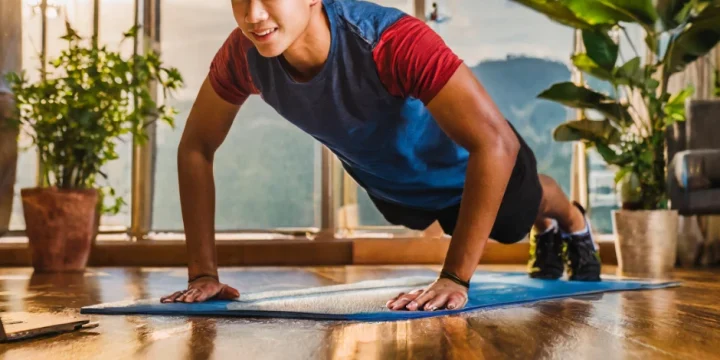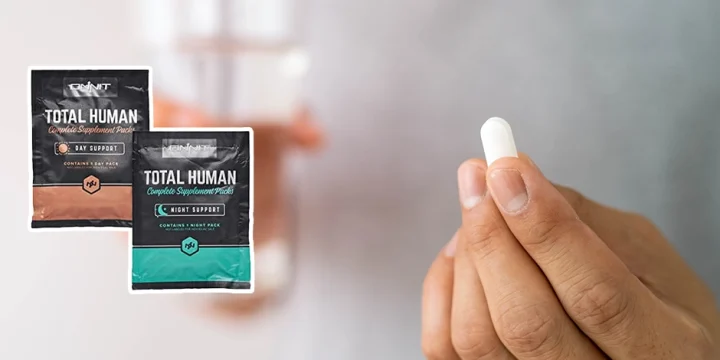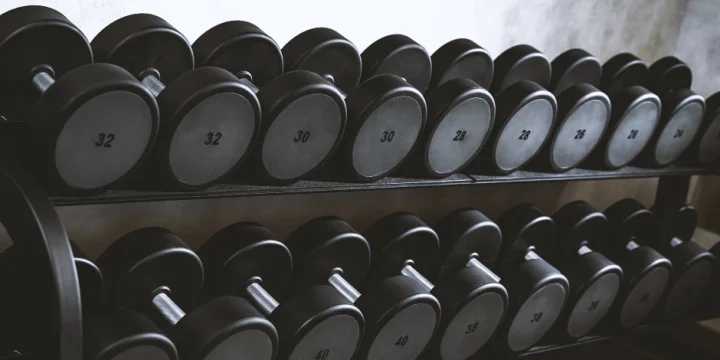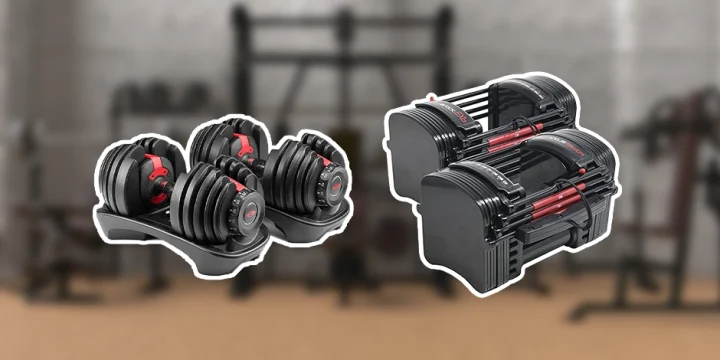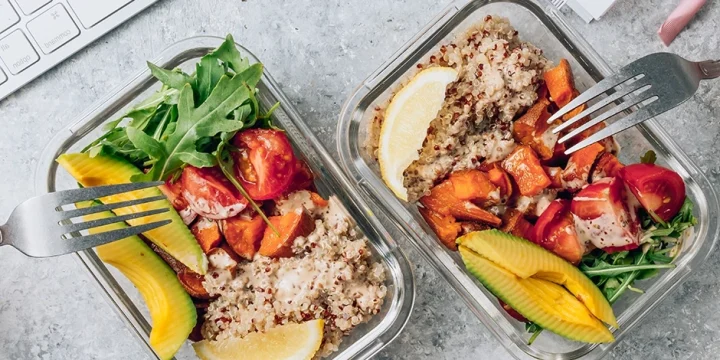Weight plates are one of the most important pieces of gym equipment. They allow you to perform the top three lifts: squats, deadlifts, and bench presses.
Choosing the right number of weight plates for your home gym takes careful planning and an understanding of your current strength level and long-term fitness goals.
With over a decade of experience training people in their home gyms, I’ve collected enough data to help you figure out how many weight plates you need for your home gym.
Let’s get started.
Quick Summary
- Every beginner needs at least one pair of every standard weight plate and a 45-pound Olympic bar for their home gym; they can add more as they get stronger with their lifts.
- How many weight plates you choose will depend on whether you’re a beginner, intermediate, or elite lifter.
- According to the article published in the New York Times, iron-weight plates might be a safety hazard, especially if you like working out barefoot.
- Based on my years of training, I recommend prioritizing quality and variety in weight plates for a truly comprehensive home gym.
How Many Weight Plates Do You Need for Your Home Gym?

You need at least a pair of each set of standard weight plates for your home gym.
This will allow you to work out with different weight combinations.
While one pair of each is enough, our experience with training all levels of lifters shows the following standard set works best if you’re going for a modest home gym setup:
- 4 x 45 lbs (4 x 20 kgs)
- 2 x 35 lbs (2 x 15 kgs)
- 4 x 25 lbs (4 x 10 kgs)
- 2 x 10 lbs (2 x 5 kgs)
- 4 x 5 lbs (4 x 2.5 kgs)
- 2 x 2.5 lbs (2 x 1 kg)
- A 45-lb Olympic barbell (20 kg)
This standard set gives you a total of 440 lbs in pound plates (or 211 kg in kilogram plates), a barbell, and quality weight plates.
Intermediate and elite lifters can also opt for one or two pairs of 25-kg plates (55 lbs) to make loading weights easier when increasing their lifts.
Isn’t a Plate Set of 440 Pounds Too Much for a Beginner?
No, a plate set of 440 pounds isn’t too much for a beginner.
The reason is that your home gym is a long-term investment, as is your fitness journey.
Lifters who are serious about progress and how much weight they lift can benefit from having more plates.
How To Choose Based on Your Level

How many weight plates you need depends on where you are on your lifting journey.
While beginners need the least number of plates and elites the most, it might also depend on how strong you are.
In my experience as a fitness trainer, I've observed that even among beginners, those with a naturally higher strength level may benefit from a slightly larger set of plates.
Here’s our recommendation for how many plates you choose based on skill level.
Beginner Lifters
Beginner lifters can start out with the above-mentioned standard set of weight plates.
It gives them a reasonable amount of weight for all their key lifts while giving them the option of various loading combinations.
I’ve personally seen many beginners excel with some lifts and struggle with others.
So, the lighter weight plates allow them to start off with lighter weights on more difficult lifts, and the heavier plates allow them to load on lifts they’re good at.
A quick note: once beginners get stronger, they’ll require smaller weight plates to progressively overload their lifts.
So, if you’re a beginner who’s advancing in their lifts, the standard set is just a starting point. You might find yourself buying more 2.5 and 5-pound weight plates as you progress.
Intermediate Lifters
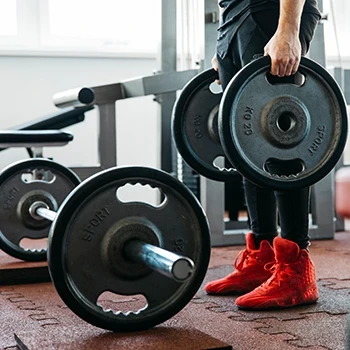
If you’re an intermediate lifter, then your setup might look different from the standard set mentioned above because you'll need a range of weights that will be conducive to your progress.
At this stage, you want to invest in a good number of mid-range weight plates because you might not be jumping loads as quickly as a beginner.
So, you'll need more of all the weights under 35 pounds.
A set of weight plates for intermediate lifters will look something like this:
- 4 x 45 lbs (4 x 20 kgs)
- 2 x 35 lbs (2 x 15 kgs)
- 8 x 25 lbs (8 x 10 kgs)
- 6 x 10 lbs (6 x 5 kgs)
- 6 x 5 lbs (6 x 2.5 kgs)
- 2 x 2.5 lbs (2 x 1 kg)
This gives you a total of 545 lbs in pound-weight plates (or 257 kg in kilo-weight plates).
Advanced Lifters
As an advanced lifter, you want to plan your weight plates more carefully.
Weight plates play a crucial role in competitive sports, including powerlifting and Olympic weightlifting.
The standardization of equipment, like weight plates, is essential for fairness and safety in these competitions, highlighting the importance of choosing the right plates if you're doing it competitively.
As an elite trainer lifting heavier loads, you'll require heavier plates. While you may not need many smaller plates, keeping them is beneficial for incremental improvements.
Here's what an elite set of weight plates will look like:
- 10 x 45 lbs (10 x 20 kgs)
- 4 x 25 lbs (4 x 10 kgs)
- 4 x 10 lbs (4 x 5 kgs)
- 2 x 5 lbs (2 x 2.5 kgs)
- 2 x 2.5 lbs (2 x 1 kg)
This gives you a total of 605 lbs in pound-weight plates (or 267 kg in kilogram weight plates).
Some Considerations
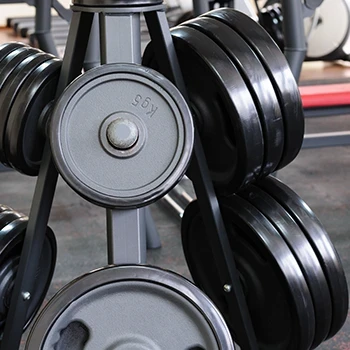
Here are a few things to take into consideration when getting weight plates:
- How many weight plates you’ll need will depend on your body weight-to-lift ratio. For example, a genetically stronger beginner lifter might need more plates than a smaller experienced lifter. So, account for those differences when choosing weight plates.
- Have separate bars for your bench press, deadlift, and squat. This makes loading and unloading easier when you switch lifts.
- It’s always good to have an extra set of lighter weights if you gradually want to improve your one-rep max.
Cast Iron Vs. Bumper Plates

One of the many questions people have when building a home gym is whether they should choose cast iron plates or bumper plates. Both have their pros and cons.
Here’s how you can choose:
Cast Iron Weight Plates
In my experience, most lifters (especially elite ones) prefer iron weights.
Firstly, they have a raw aesthetic that adds to the lifting experience.
Secondly, most lifting competitions use iron plates as a standard (except for some Olympic weightlifting contests). So lifters prefer the feel of these plates to prepare for their competitions.
However, we wouldn’t recommend iron plates if your home gym doesn’t have thick rubber flooring. Also, if you prefer working out barefoot, the New York Times reports that iron-weight plates might be a safety hazard if you accidentally drop them [1].
Bumper Weight Plates
Bumper plates are ideal for beginners and for safer home gym practices. They're also more forgiving on foam pads when dropped after heavy lifts.
While not essential, installing protective flooring in your home gym extends the life of both your plates and floor.
Engaging in weightlifting with preferred equipment, whether iron or bumper plates, can enhance mental well-being, reduce stress, and contribute to a sense of accomplishment, especially as lifters meet their lifting goals.
Do You Need 35-Pound Plates?
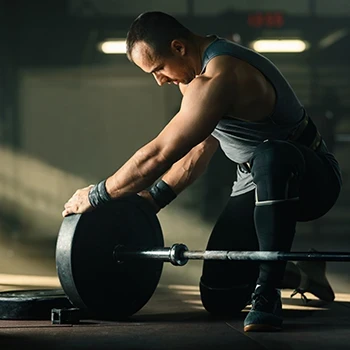
No, you don’t need 35-pound plates. But it’s good to have them, especially if you’re a beginner or working with weight increments that require a little more than 35 pounds on each side of the barbell.
Also, there could be scenarios where you’d need 115 pounds as your warm-up set.
I’ve seen many beginners deadlift and bench. In such cases, 35-pound plates are the perfect warm-up increment before moving onto heavier sets.
However, you can build your bar to 115 pounds using a standard plate set.
But if you have enough in your budget for a 35-pound plate, it doesn’t hurt to have a complete set of plates.
How To Deal With Clutter
The easiest way to deal with clutter (especially if you find yourself getting more weight plates) is to invest in a weight plate stand.
While most quality squat racks have weight pegs for storing plates, you might also need an extra shelf depending on how many plates you add.
Considerations Before Purchasing

Buying weight plates is a long-term investment. So, you need to take several things into consideration before investing in them.
- Long-term fitness goals: Plan out your fitness program and progress for the next five years. This will help you budget for how many weight plates you’ll need.
- Relocation: Think twice about investing in multiple plates if you plan on moving somewhere within a year. You don’t want to be a hassle with too many plates.
- Weight plate sizes: Different companies make weight plates of different sizes. Go for the smaller ones if you’re tight on space and storage.
- Plate grip: You can either opt for solid plates or Olympic grip plates. The latter is easier to carry, load, and unload.
- Weight training exercises: The kind of plates you choose will depend on your weight training regimen. Powerlifters might opt for iron-weight plates, while weightlifters might choose rubber plates.
FAQs
Should I Get Kg or Lb Plates?
You should get kg or lb plates, depending on what weighing system you’re most comfortable with. Most Americans prefer and use pound plates. But people from countries that use the metric system might be more comfortable using kilogram plates.
What To Know Before Buying Weights?
You need to know how heavy you lift on most exercises before buying weights. This will help you determine what weights to start out with and which ones you plan to progress with. For beginners, it’s better to buy a set of weights that will prepare them for becoming intermediate lifters.
Are 20-Pound Plates Good for Beginners?
Yes, 20-pound plates are good for beginners. However, it also depends on your strength levels. Most beginners can do many exercises with two 20-pound plates and a 20-pound barbell. They make an excellent start for deadlifts.
Does the Order of Weight Plates Matter?
No, the order of the weight plates doesn’t matter as long as you’re storing them the same way on each side of the rack or barbell. That said, it’s better to have a rack with enough weight pegs so you can store one of every weight plate on each side.
How Do I Choose a Weight Plate?
Choose a weight plate based on its brand, quality, and material. Good brands can withstand the test of time and multiple drops. You can choose between iron and bumper plates based on your personal preference or the strength of your flooring and mat.
What Is a Row Plate on a Home Gym?
A row plate on a home gym is an attachment or part of a machine used for performing rowing exercises, typically targeting the back muscles. It's where you place or attach weights for resistance during the rowing motion.
References:
- https://www.nytimes.com/2022/09/09/well/move/barefoot-weight-lifting.html
About The Author
You May Also Like
